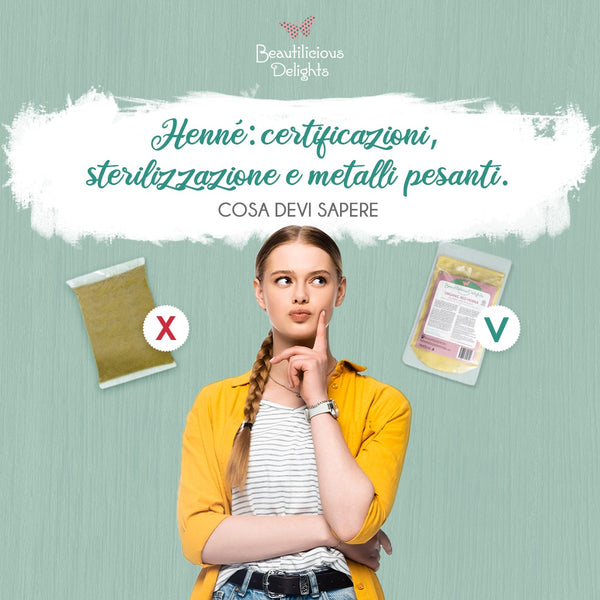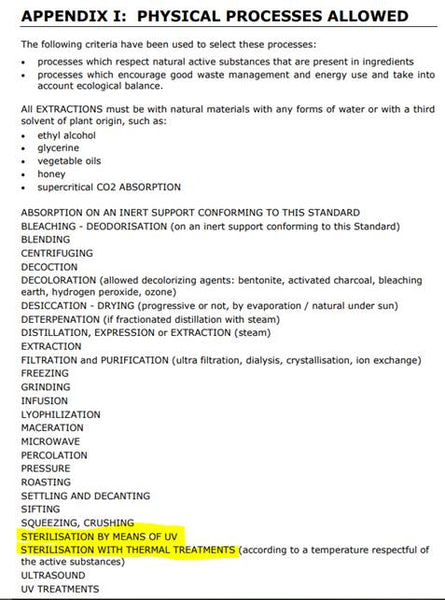Dopo l'approfondimento della settimana scorsa su
Cos'è il Lawsone/Naftochinone, Divieto in caso di Favismo e Rischio Allergie, oggi mi piacerebbe proseguire parlandovi di altri argomenti come:
-
le Certificazioni e cosa attesta acquistare un prodotto certificato,
-
la sanificazione e sterilizzazione delle erbe tintorie
-
la rilevazione dei metalli pesanti nelle erbe tintorie e ayurvediche.
Questa scelta 'naturale', l'henné e le erbe tintorie, richiede attenzione e consapevolezza perché, ancora una volta, ribadisco che il ‘naturale’ dichiarato in etichetta non vuol dire che il prodotto sia innocuo, al di là del sincerarsi sempre che un prodotto sia adatto per la propria cute e pelle e che non dia reazioni di tipo allergico.

Certificazioni. Cosa significa scegliere di acquistare un prodotto certificato:
-
Maggiore sicurezza d'uso?
-
Qualità migliore?
-
Prodotto testato e controllato?
-
Senza sostanze tossiche?
-
Cruelty-free?
-
Senza Nichel?
Queste sono solo alcune risposte inesatte che attestano la grandissima confusione che regna sovrana quando si tocca questo argomento e spero che alla fine della lettura di questo articolo, gran parte di questa confusione sia stata spazzata via.
Chi rilascia la certificazione?
Esistono degli enti certificatori privati nazionali e internazionali che propongono un proprio disciplinare alle quali le aziende possono aderire per poter ottenere la certificazione bio - naturale - vegan - halal, ecc e i rispettivi bollini da usare in etichetta.
Le certificazioni europee più famose sono Cosmos e Natrue mentre in Italia gli enti certificatori più conosciuti sono il CCPB, ICEA, AIAB, ecc.
Esistono anche delle certificazioni come VEGAN OK - certifica che viene rispettata l'etica vegana - certificazione basata sull'auto-dichiarazione e che presume che l'azienda che ci aderisce potrebbe essere soggetta ad eventuali controlli da parte dell'ente certificatore.
Le erbe tintorie Beautilicious Delights sono certificate da ECOCERT con lo standard europeo COSMOS, disciplinare nato dalla collaborazione tra i principali enti di certificazione e organizzazioni internazionali del settore.
Quindi, per ovvie ragioni, posso parlavene e approfondire cosa attesta la certificazione COSMOS ORGANIC oppure COSMOS NATURAL.
Cosa garantisce la certificazione?
In questo specifico caso, vi posso dire cosa garantisce la certificazione COSMOS.
Il disciplinare Cosmos :
-
prevede processi di produzione e di trasformazione rispettosi dell'ambiente e della salute dei consumatori
-
proibisce l'utilizzo dei nanomateriali
-
prevede lo sviluppo del concetto di chimica verde
-
richiede l'utilizzo responsabile delle risorse naturali
-
richiede il rispetto della biodiversità
-
richiede l'assenza d'ingredienti petrochimici (trane i conservanti autorizzati): paraben, phenoxyethanol, profumi e coloranti di sintesi
-
prevede l'assenza d'OGM e derivati da OGM
-
vieta l'irradiazione con raggi gamma o x
-
vieta i test su animali
Tutti i prodotti commercializzati con il logo Cosmos Organic e Cosmos Natural sono stati controllati dall'ente certificatore (Ecocert): dalla composizione ( dall'INCI) e dal processo di lavorazione, trasformazione e produzione fino alla convalida dell'imballaggio.
La certificazione biologica dell'henné e delle erbe tintorie e ayurvediche offre anche un’ulteriore garanzia sulle metodiche utilizzate nella coltivazione e nell'agricoltura e certifica l’assenza di impiego di OGM o altri ibridi non ammessi.
Lo stesso disciplinare richiede che i diversi processi di produzione siano separati per prevenire la contaminazione di ingredienti biologici o naturali.
Deve essere inoltre presente un sistema di controllo della qualità che includa:
-
tracciabilità completa degli ingredienti e dei prodotti finali
-
procedure standard di produzione in tutte le fasi
-
test di ingredienti e prodotti
-
registrazioni di analisi, produzione e conservazione.
Il nostro fornitore segue le regole di corretta coltivazione e raccolta (GACP) - seguendo le Linee Guida per la Buona Pratica Agricola per tutte le sue piante.
Mantiene un sistema di produzione sterilizzato in ogni fase di lavorazione, partendo dalla selezione dei semi fino al confezionamento dei prodotti finiti.
Il regolamento (CE) N. 1223/2009 stabilisce norme che ogni prodotto cosmetico immesso sul mercato deve rispettare, al fine di garantire il corretto funzionamento del mercato interno e un livello elevato di tutela della salute umana.
Quindi un prodotto cosmetico, certificato o meno, per il semplice fatto che viene commercializzato si presume che sia sicuro per la salute del consumatore perché altrimenti non sarebbe a norma di legge.
Sincerarsi che l'uso del prodotto avvenga in sicurezza spetta al singolo produttore - che si tratti di rossetti, creme viso, shampoo capelli o henné capelli.
Sanificazione e Sterilizzazione dell'Henné e delle Erbe Tintorie
L'henné e le erbe tintorie sono tornate alla ribalta solo negli ultimi 6-7 anni ed il mercato delle piante tintorie e riflessanti è in pieno boom.
Rappresentano un universo davvero complesso proprio perché si tratta di piante essiccate e polverizzate a rischio di contaminazioni batteriche ancor di più considerando che NON tutte le fabbriche di lavorazione e produzione sono attrezzate per lavorarle adeguatamente e in sicurezza, senza contaminazioni e proliferazioni batteriche.
Ecco una delle ragioni che ci hanno portato ad affidarci a un singolo produttore certificato con lo standard Cosmos e i cui stabilimenti di produzione e lavorazione delle erbe tintorie seguono le linee guida del disciplinare Cosmos.
E' necessario sanificare / sterilizzare l'henné?
Come forse già sai, le polveri che utilizziamo per colorare / lavare o semplicemente coccolare i nostri capelli sono il risultato dell'essiccazione e della micronizzazione di alcune specifiche piante (tintorie, riflessanti o dalle proprietà detergenti grazie alle saponine vegetali che contengono).
Una minima carica batterica è presente anche naturalmente nelle piante.
In base alle condizioni di igiene e umidità degli stabilimenti di produzione e stoccaggio, in base alla salubrità degli impianti di lavorazione, queste polveri possono presentare una carica batterica importante, muffe e lieviti e in alcuni casi anche agenti patogeni.
"Le buone pratiche di fabbricazione dovrebbero essere in grado di garantire che i prodotti, pur non necessariamente sterili, non contengono organismi pericolosi e che la popolazione microbica di fondo si mantenga stabile e in basse concentrazioni." (fonte Rapporti ISTISAN 13-15)
In un estratto della Norma UNI EN ISO 17516:2015 “Cosmetici- Microbiologia – Limiti microbiologici“ troviamo le seguenti linee guida:
La presente norma internazionale fissa i limiti microbiologici per i cosmetici.
Se il processo di lavorazione delle erbe tintorie avviene dal principio in tutte le fasi di lavorazione in locali sterilizzati e ben ventilati il rischio di contaminazione e deterioramento delle polveri si riduce al minimo.
Se però le condizioni di lavorazione e trasformazione del prodotto sono favorevoli, i batteri possono proliferare.
In questi casi sarebbe essenziale effettuare la sanificazione / sterilizzazione delle polveri per abbattere la carica batterica e azzerare gli agenti patogeni.
Dico "sarebbe essenziale" perché la stra-grande maggioranza degli stabilimenti indiani NON effettuano la sanificazione e NON abbattano la carica batterica presente nelle polveri perché non sono strutturati per poterla effettuare.
In più va detto che NON è mandatorio fare la sterilizzazione / sanificazione al fine dell'esportazione di tali polveri per la cura dei capelli.
L'henné e le polveri Beautilicious Delights vengono sanificate / sterilizzate?
Il nostro fornitore indiano usufruisce di un processo di produzione sterilizzato in tutte le fasi di lavorazione, dal raccolto delle piante fino al confezionamento dei prodotti finiti.
La struttura dove vengono lavorate le piante è sterilizzata e ben ventilata per proteggere il raccolto dall'umidità e da altri possibili agenti contaminanti.
Le piante una volta raccolte vengono analizzate tramite test organolettici e sensoriali per quanto riguarda il colore, l'aroma, la dimensione e l'aspetto della pianta.
In seguito, passato questo primo step di approvazione della materia prima, si procede a test specifici per rilevare l'E. coli, muffe, batteri, coliformi, salmonella e lieviti.
Per l'essiccazione e la polverizzazione delle piante vengono utilizzati impianti all'avanguardia mentre per la sanificazione delle polveri tintorie viene utilizzato un impianto di sterilizzazione a vapore e un impianto di raffreddamento di ultima generazione che permettono di mantenere un'alta qualità delle polveri senza alterare i principi attivi delle piante.
Se viene riscontrata una contaminazione microbiologica si procede alla sanificazione del lotto usando l'impianto all'avanguardia di sterilizzazione a vapore.
In seguito vengono svolte anche analisi per rilevare i livelli di afla-tossine, di tracce di pesticidi e antiparassitari, tutto questo nonostante le piante provengano da agricoltura biologica e/ o spontanea nelle quali i pesticidi e gli antiparassitari non vengono proprio utilizzati.
In più tutti i prodotti vengono testati per rilevare la presenza e i livelli di metalli pesanti (piombo, mercurio, arsenico, cadmio).
La certificazione BIO esclude la sanificazione?
Alcune di voi mi hanno segnalato che c'è chi dice che le erbe sterilizzate / sanificate NON possono essere certificate bio perché solitamente la sanificazione viene effettuata con l'irradiazione con raggi gamma o X, processi fisici vietati nei disciplinari bio (come abbiamo visto anche sopra quando abbiamo parlato di Certificazione).
Informazione errata perché fortunatamente esistono anche altri tipi di processi fisici per effettuare la sanificazione dell'henné e delle polveri, come la sanificazione con trattamenti termici.
Lascio nell'immagine qui sotto, l'appendice I del disciplinare COSMOS dal quale si evince l'ammissione della sanificazione attraverso la sterilizzazione a vapore.

I processi di sanificazione attraverso l'irradiazione con raggi Gamma o raggi X NON sono ammessi dai disciplinari bio in quanto ci sono ancora troppi pochi studi in merito all'incidenza che tale procedimento possa avere sul fitocomposto della pianta che viene comunque modificato in seguita a tale procedura.
Tirando le somme, NON è vero che una polvere per capelli certificata BIO può contenere batteri, muffe e agenti patogeni perché presumibilmente non è stata sanificata.
Sta ovviamente al singolo produttore sincerarsi del processo di produzione e di effettuare i procedimenti di sanificazione quando necessario ma la certificazione biologica NON esclude a priori che il prodotto sia stato sanificato proprio perché esistono processi fisici come la sterilizzazione a vapore, ammessi dai disciplinari bio.
Quindi per ogni lotto d’importazione Beautilicious Delights vengono forniti i certificati con la conta microbiologica, metalli pesanti e assenza di pesticidi.
Qui sotto trovi l'esempio di un certificato, preso a campione, rilasciato per l'Indigo.
Conta microbica e ricerca (assenza) di patogeni che poi viene effettuata anche in Italia da un laboratorio esterno.
Qui sotto trovi l'esempio di un altro certificato, preso a campione, rilasciato per il Kapoor Glow. I test vengono effettuati su tutte le polveri per capelli, sia tintorie che riflessanti, lavanti oppure ayurvediche come il Kapoor.
Ovviamente, anche in questo caso, per un discorso di privacy, i dati del laboratorio che rilascia i certificati sono stati oscurati.
I metalli pesanti - cosa dice la legge?
I metalli pesanti sono sostanze ampiamente diffuse nell’ambiente, presenti naturalmente nelle rocce, nel suolo e nell’acqua, e pertanto si possono ritrovare nella lavorazione di coloranti e di altre materie prime impiegate in tutte le industrie, compresa quella cosmetica.
Proprio perché la loro presenza è ubiquitaria nell'ambiente, è praticamente impossibile evitare la quotidiana esposizione ai metalli pesanti.
Studi di tossicologia hanno dimostrato che i metalli pesanti hanno un potenziale tossicologico: alcuni metalli pesanti non danno problemi di tossicità, ma a certe concentrazioni e su persone predisposte, sono in grado di scatenare reazioni allergiche.
Alcuni metalli sono stati usati, in passato, come ingredienti nei prodotti cosmetici, come, ad esempio, l’acetato di piombo utilizzato come colorante per capelli e il rosso cinabro (solfuro di mercurio) usato già ai tempi dell’impero romano.
Tale presenza è accettata solo se:
- I metalli pesanti sono presenti a livello di tracce tecnicamente inevitabili;
- Se la presenza si verifica nonostante l'osservanza di pratiche di buona fabbricazione;
- Il prodotto cosmetico è stato valutato come sicuro dal Valutatore della Sicurezza nelle condizioni d'uso normali o ragionevolmente prevedibili.
Esiste un valore limite per i metalli pesanti consentita nei prodotti cosmetici?
Come sopra specificato, Il Regolamento (CE) 1223/2009 indica che la presenza dei metalli pesanti, in tracce tecnicamente inevitabili, è tollerata ma non è di fatto stato definita una soglia massima globale per i metalli pesanti nei cosmetici.
Ad oggi non è ancora ben chiaro qual è il limite per i metalli pesanti al di sopra del quale il prodotto cosmetico non è conforme e non è ancora indicato chiaramente un limite individuale per ciascuno dei metalli pesanti.
Quindi quando nell'articolo 17 del Regolamento (CE) 1223/2009 viene menzionata "quantità ridotta di sostanza vietata" di fatto non esiste un valore di riferimento.
Esistono studi epidemiologici condotti dall’ISS (Istituto Superiore di Sanità) che giungono alla conclusione che una concentrazione massima di 1 ppm sia sicura, ma non c’è una concordanza a livello Europeo.
Considerato che l’Unione Europea non ha ancora definito la concentrazione dei metalli in un cosmetico che può essere definita come “traccia tollerabile”, il Rapporti ISTISAN 14/14 ha indotto alcune Autorità dei singoli Stati Membri ad adottare misure transitorie e a stabilire dei valori orientativi da rispettare che trovi elencati qui di seguito.
Claim: Metal free?
Non esistono prodotti “privi di metalli pesanti” perché come abbiamo appurato i metalli pesanti sono sostanze ubiquitarie e, dunque, si possono riscontrare tracce in qualsiasi prodotto, cosmetico o alimentare, così come nell’ambiente e in natura.
Il claim “metal free” è di conseguenza ingannevole se viene usato per indicare che i metalli pesanti non sono impiegati come ingredienti del cosmetico perché è già proibito dalla legge.
Nickel free o Nickel tested?
Le piante accumulano i metalli, tant'è che alcune sono usate per bonificare i terreni contaminati. Il nickel, come tutti gli altri metalli pesanti, è presente in natura e NON è possibile avere un prodotto che ne contenga 0%. Quindi la normativa prevede che i prodotti cosmetici possono contenere "tracce" di nickel, ossia entro una certa percentuale.
Il claim "NICKEL FREE" NON è a norma di legge perché non si può avere la certezza che sia stato eliminato del tutto.
Il claim "NICKEL TESTED" significa che c'è una certificazione volontaria da parte dell'azienda che attesta che il valore del nickel all'interno del prodotto è inferiore a una certa quantità.
Su SITOX INFORMA, il Periodico della Società Italiana di Tossicologia (Anno XVI n. 1 - Maggio 2013) è stato pubblicato un Consensus Document sui residui inevitabili di metalli pesanti come impurezze nei cosmetici.
Spero di essere riuscita a essere quanto più esauriente possibile, ma per qualsiasi dubbio, vi aspetto nell'area commenti qui sotto.
©Beautilicious Delights
Nel negozio online trovi tutto il necessario (erbe tintorie incluse) per prenderti cura della tua pelle e dei tuoi capelli in modo consapevole. Clicca QUI per visitarlo!
**************************************************************************************
Rimani in contatto con noi:
Seguici sui SOCIAL cliccando sulle icone che trovi qui sotto per rimanere sempre aggiornato/a sulle ultime novità:
Rozalia & il Team Beautilicious Delights.








